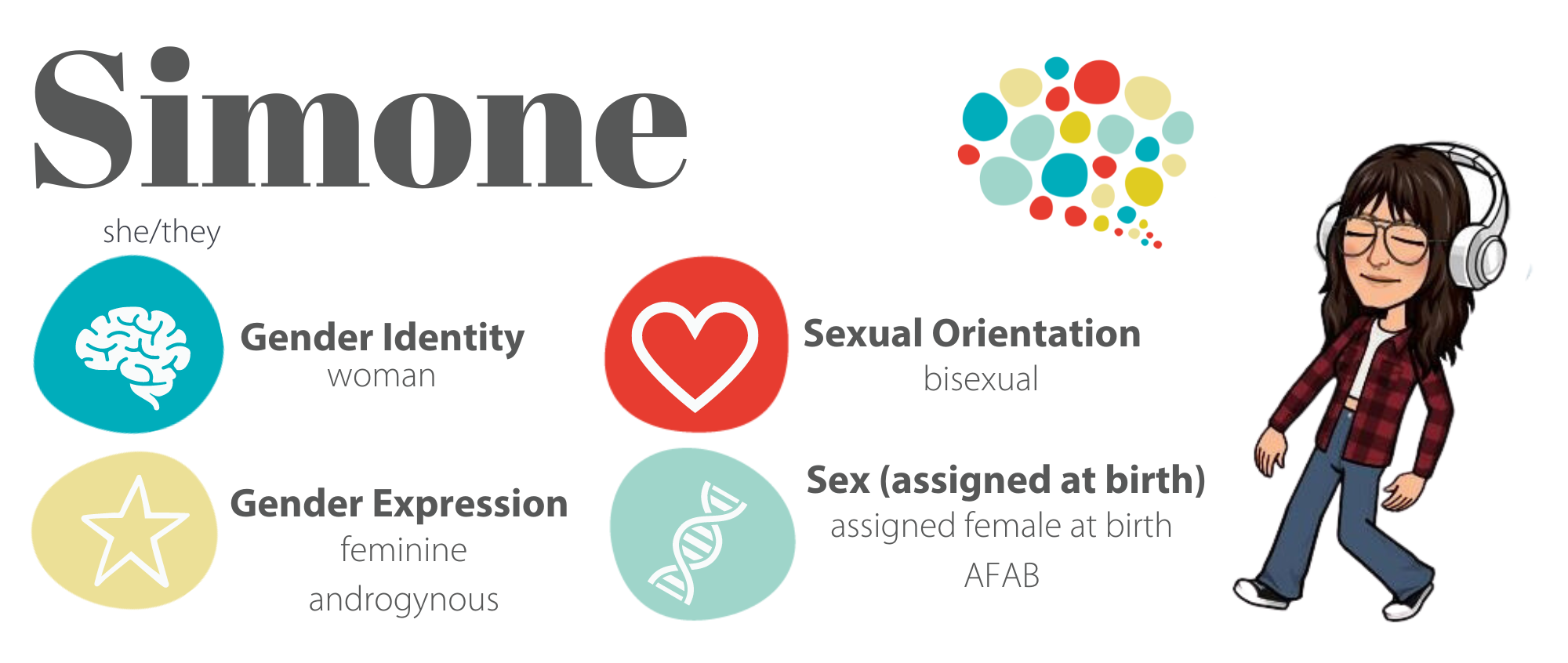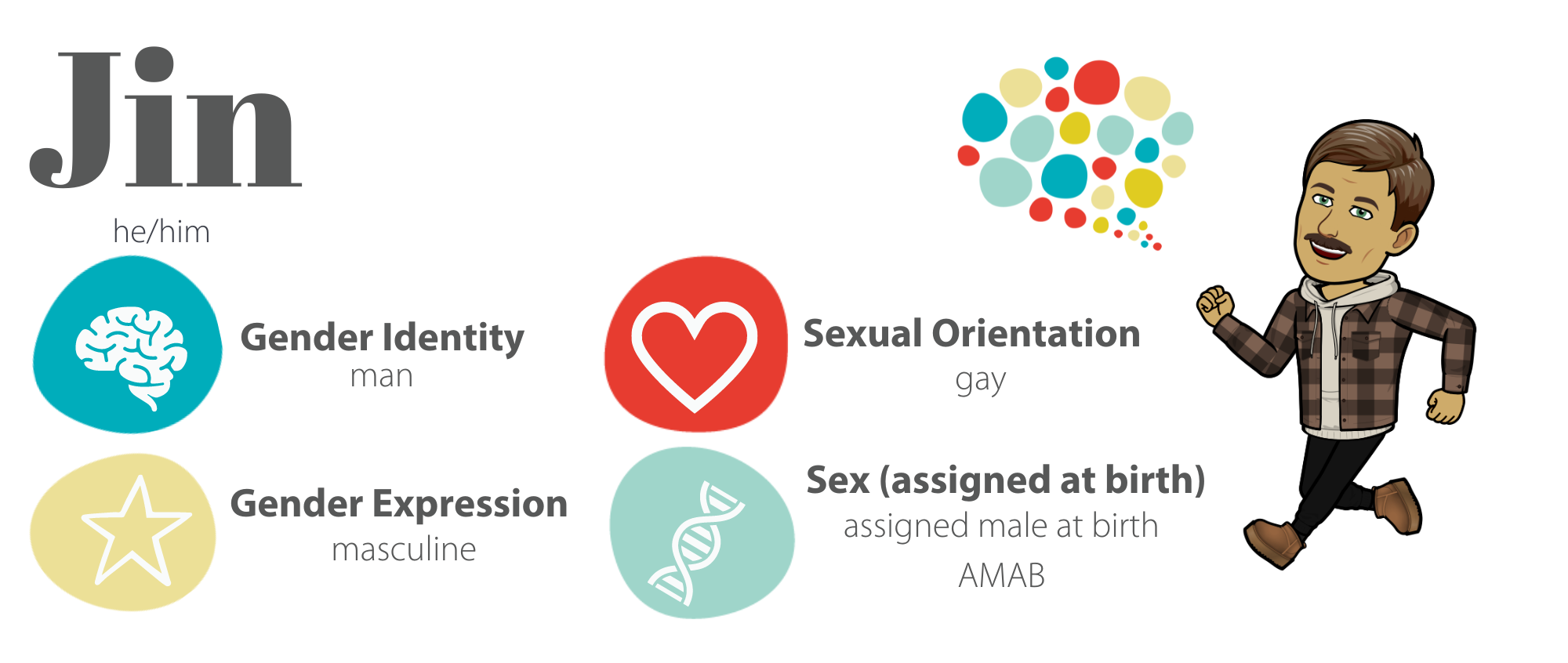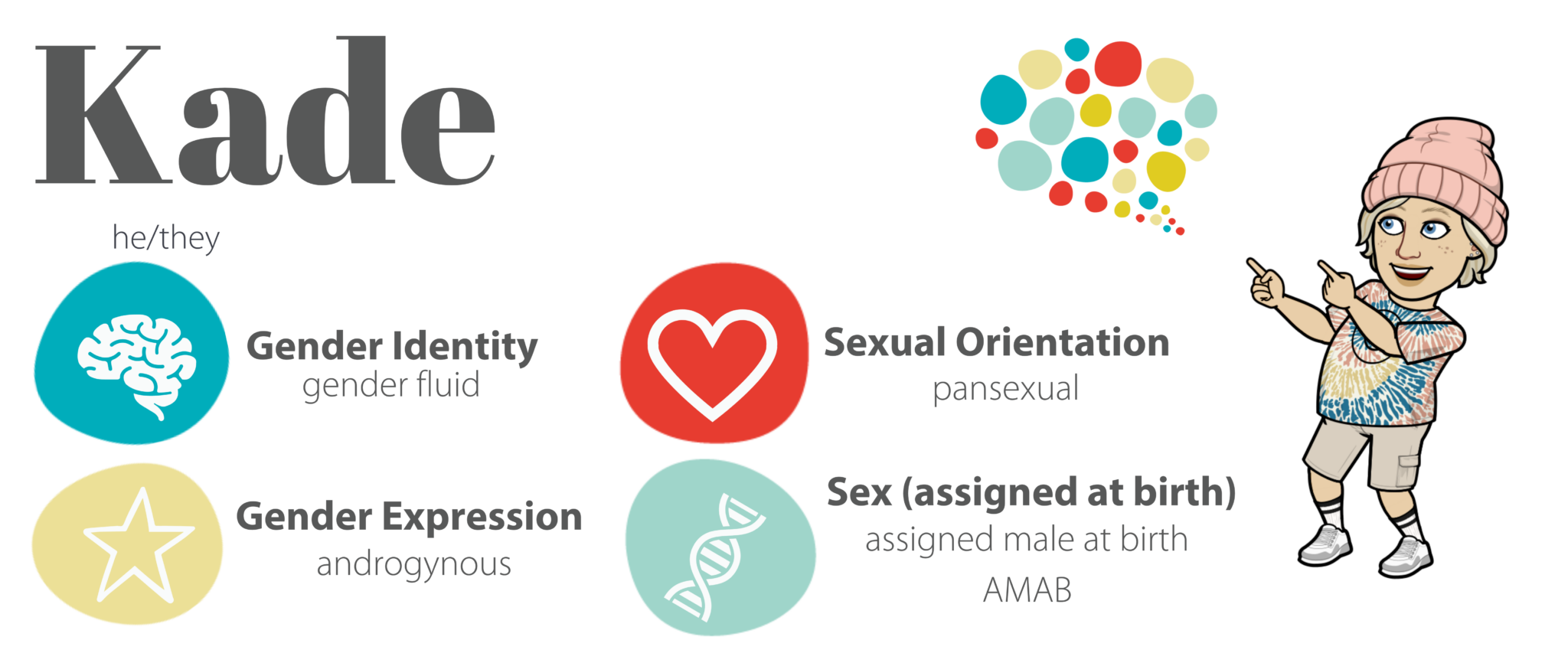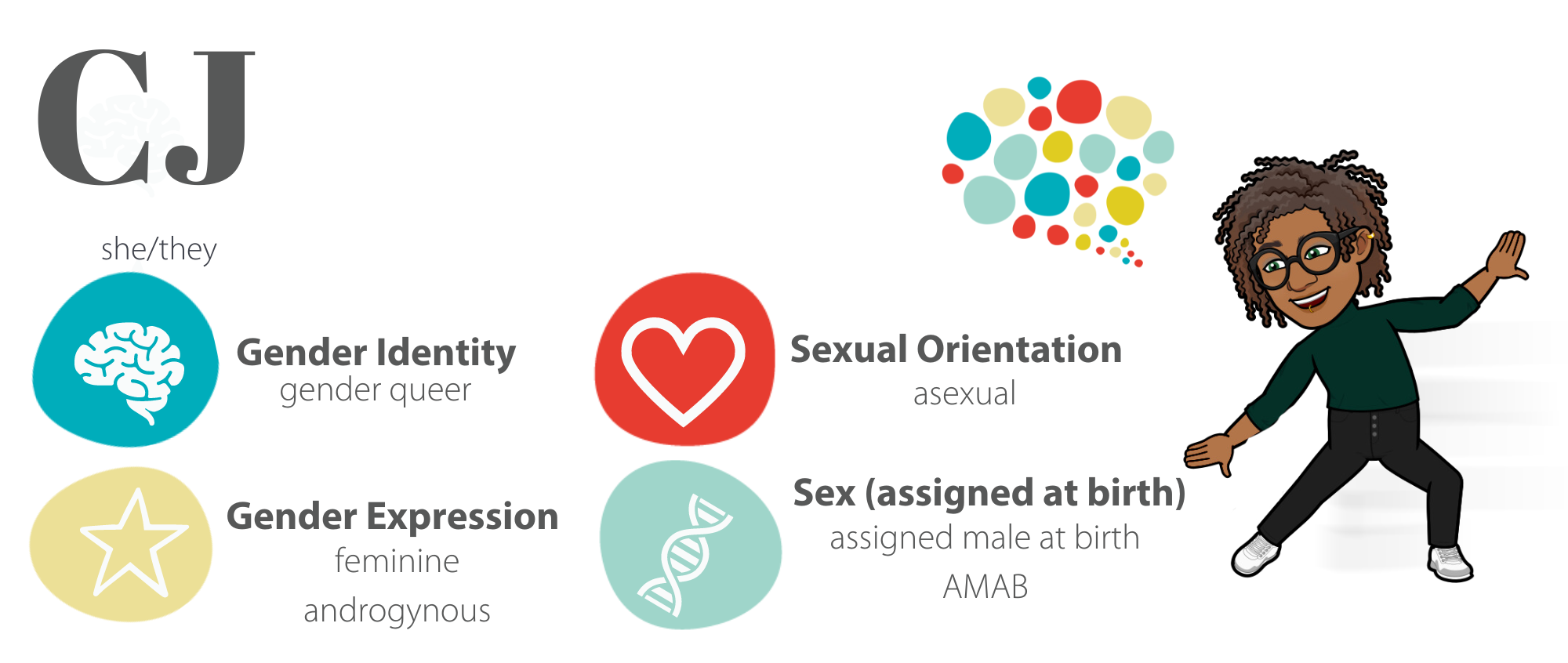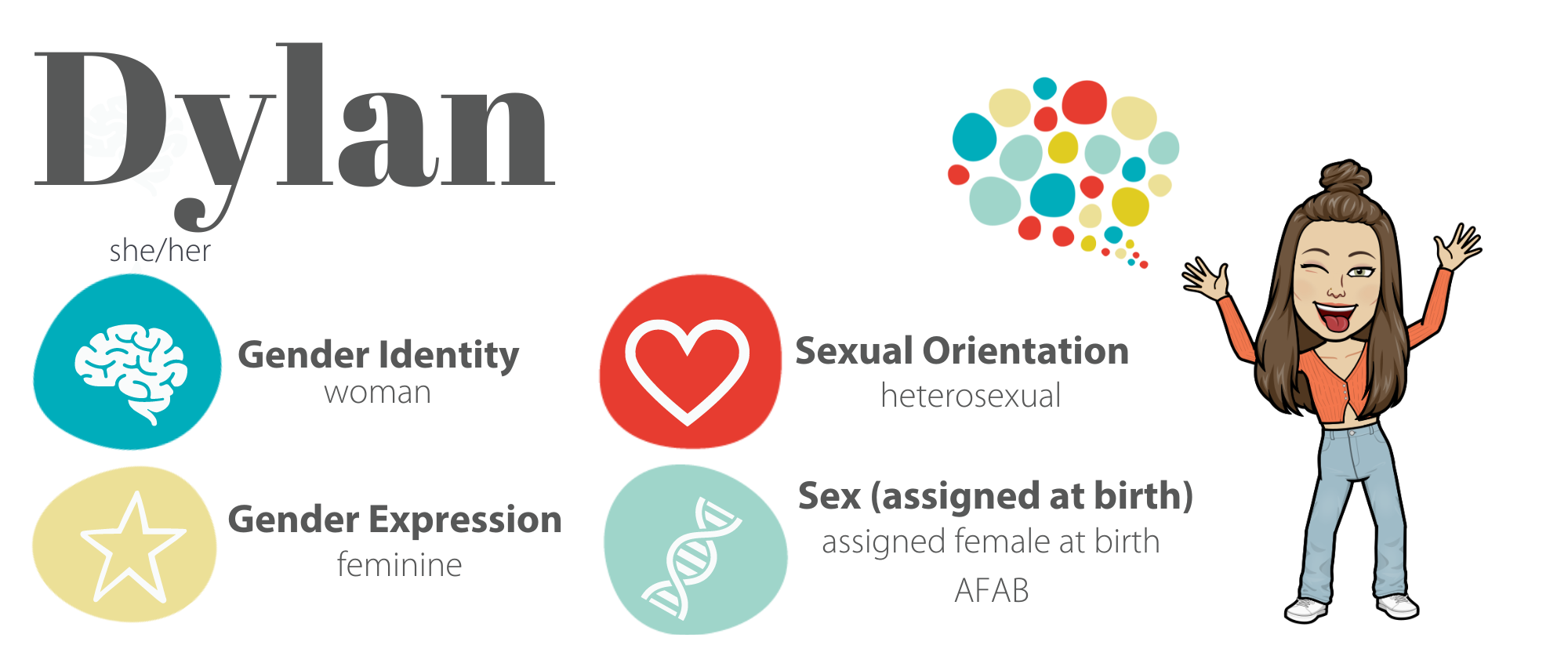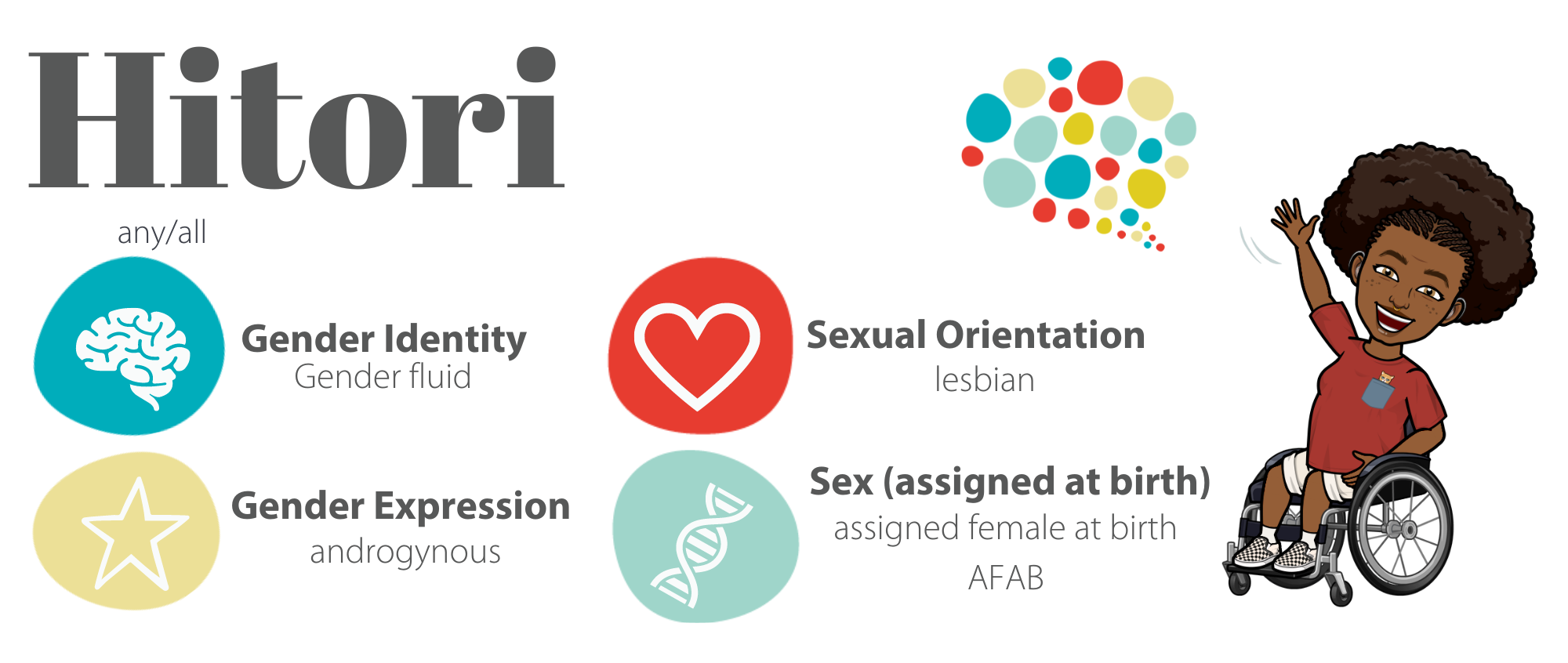Sexual Orientation
The information on this page is provided as additional learning and background knowledge for educators. Sexual orientation is not included in any bolded and italicized outcomes in the Alberta curricula that require parental notification under Section 58.1(1) of the Education Act.
Everyone has a sexual orientation. Sexual orientation refers to a person’s emotional, physical and sexual attraction to others. Each person’s sexual orientation is a part of who they are. Some people know at a very early age what their sexual orientation is, and others may not. A person’s sexual orientation might stay the same over their whole life, or it may change. Gender identity is not the same as sexual orientation.
The examples below illustrate that a person’s identity is a combination of gender identity and expression, sexual orientation and sex. People use words like heterosexual, lesbian, queer, asexual to define their sexual orientation. Definitions of these words and more can be found here.
To learn about how gender identity and sexual orientation relate to each other, see the Every Body Tool.
The Alberta curriculum invites discussion of families. For example,
- Grade 1 Social Studies: Students will demonstrate an understanding and appreciation of how changes over time have affected their families and influenced how their families and communities are today
- Grade 3 Phys Ed and Wellness: Family structures can vary; may include extended family; and may consist of a single parent, a mother and a father, stepparents, two fathers, or two mothers
Talking about the variety of family structures, including families with same-gender parents, is an excellent opportunity to demonstrate inclusion in your classroom. Families can look very different from each other, but all loving family units are valid.
Heteronormativity
Many people use words that assume everyone is heterosexual (straight). This is called heteronormative language. For example, a form that asks for ‘mother and father’s names’ assumes that all kids have two straight parents. Saying ‘when a girl grows up and has a boyfriend’ assumes that all girls are straight and are attracted to boys. This kind of language reinforces stereotypes and assumptions about who people are, who they are attracted to, and who they can love. When we make assumptions about people’s orientations or relationships, we may be telling them that anyone who does not fit such an expectation is ‘abnormal’, ‘different’, or just not part of the ‘typical human experience”. Using inclusive language that does not make assumptions is a way of showing respect and honouring diversity as a strength. You can’t assume someone’s sexual orientation by looking at them.
2SLGBTQI+, LGBTQ2S+, LGBTQ*, LGBTQ+, GLBT, LGBTTQ, LGBTQ2, LGBTQI2SNA+ and others are acronyms that refer to the spectrum of sexual and gender identities that are not cisgender or heterosexual. These identities include two-spirit, lesbian, gay, bisexual, transgender, non-binary, queer, questioning, intersex and asexual. The asterisk (*) or plus sign (+) shows there are other identities included that aren’t in the acronym. Another term used to refer to this community is ‘gender and sexual minorities’.
Human Rights
All people have the right to be free from discrimination against their sex, gender, sexual orientation, gender identity and gender expression. This right is protected by Article 2 of the UN Convention on the Rights of the Child, as well as in the Canadian Charter of Rights and Freedoms, the Canadian Human Rights Act and the Alberta Human Rights Act.
All teachers, counsellors and administrators have legal, ethical and professional responsibilities to ensure that all students–including those who are, or are perceived as being, a sexual or gender minority–are provided with safe, caring, welcoming and respectful learning environments that respect and affirm their individual identities and experiences. Intervening whenever sexist, homo/bi/transphobic, racist or derogatory comments are made is one crucial part of that responsibility.
It may also be helpful to become familiar with your school/district policy on creating learning environments that respect people of diverse sexual orientations, gender identities and expressions.
Lived Experiences of Sexual Minority Youth
Many sexual minority youth face challenges throughout their lives. Fear about how family and friends may react as well as fear of bullying, harassment, discrimination and prejudice may stop young people from publicly identifying as a sexual minority. Supportive families, schools and communities have a vital role helping 2SLGBTQI+ children and teens do well in school and in life.
Coming out can pose serious safety risks, particularly for young people who are not financially independent. Youth may face abuse and harassment if they come out. Some may be forced to leave home after coming out, which leads to much higher risks of homelessness, substance use, self-harm, and suicide.
Research also shows that 2SLGBTQI+ students are frequently not safe at school. Students report verbal and physical harassment and abuse from other people at school. For example, in a recent survey of Canadian students (2021):
- 48% of 2SLGBTQI+ students felt unsafe at school
- Students with an 2SLGBTQI+ parent were three times more likely to be physically harassed about their sexual orientation than students with straight parents
- 42%% of 2SLGBTQI+ students had been verbally harassed about their sexual orientation
- 30% of 2SLGBTQI+ students had been cyber-bullied vs 8% of straight cisgender students
- 27% of students reported that “most” students use homophobic language, which is higher in Grade 8 and declines as students get older
- Nearly 40% of students heard homophobic comments like “That’s so gay” daily
Kids and teens supported at home and school are more likely to stay in school, have stable living environments, and have better mental and physical health. When a school’s students, staff and parents ensure it is an inclusive space, 2SLGBTQI+ students can feel safe and thrive.
For more statistics and information, see the Additional Resources page.
What Teachers Can Do
Teachers play an important role in helping students develop and show respect for sexual and gender diversity. Here are some things you can do to support your 2SLGBTQI+ students, families and colleagues:
- Reflect on your practices and beliefs. Look at your own actions and behaviour. It may help to think about your personal values, beliefs and biases before talking about sexual orientation with your students (see the Your Values page).
- Educate yourself and others. Educate yourself about sexual and gender diversity. There are some great online resources (see Additional Resources). Think about what you can do to challenge the norm that only heterosexual and cisgender identities are normal.
- Be a role model and set a positive example for those around you. Don’t use anti-2SLGBTQI+ language and slurs. Don’t laugh at jokes that make fun of person’s sexual orientation. Use inclusive language and don’t make assumptions about a person’s sexual orientation.
- Identify and address inappropriate behaviour such as teasing, bullying and harassment. Students notice if you do not respond to these behaviours. When you fail to address harmful language, you are telling your students that you are not an ally to the vulnerable.
- Create a positive environment. Use inclusive graphics, posters and images such as safe space materials. Make sure that documents, forms and processes are respectful and inclusive of diversity.
- Be supportive. Be respectful, open and non-judgmental. Listen to people who come out to or confide in you. Keep your conversations confidential—you never want to out a person. If you make a mistake, say sorry.
- Support GSAs/QSAs, and inclusion initiatives and events.
- Get support. Be familiar with resources and supports that may help students, colleagues and staff. Engage in professional development to learn more about sexual orientation.
- Integrate 2SLGBTQI+ literature into your school or class library, assignments or reading lists.
- Be an ally. An ally is a person who advocates for the human, civil and sexual rights of sexual and gender minorities. The above steps are all things you can do to be an ally for your 2SLGBTQI+ students and colleagues. Remember, even the smallest actions can bring about changes. There is much evidence that having even one supportive adult can make all the difference in the lives of sexual and gender diverse youth.
Words You May Hear
Below is a list of common terms and definitions you may hear related to sexual orientation. These terms are NOT labels. When speaking with people, it is important to listen to and use the terms they use to describe themselves, and not impose terms on other people.
- Ally: A person who advocates for the human rights of sexual and gender minority people by challenging discrimination and heterosexism.
- Asexual: A person who does not feel sexual attraction. They may or may not feel emotional/romantic attraction.
- Bisexual: A person who has emotional, physical and/or sexual attraction to people of their own gender and other genders.
- Coming Out: Telling people about one’s sexual orientation or gender identity. Also known as ‘coming out of the closet’.
- Gay: A person who has emotional, physical and/or sexual attraction to people of the same gender. This term is most often used for a man who has an emotional or sexual attraction to men.
- Gender Expression: How a person presents their gender to the world. This can include how they look, the name they use, the pronouns they use (e.g., they, them, she, her, he him, zie, zim) and their social behaviour.
- Gender Identity: A person’s internal sense of identity as woman, man, both, fluid among genders or no gender, regardless of their sex.
- GSA/QSA: (Gay-Straight/Queer-Straight Alliance): Student groups found in some K-12 schools. These groups create supportive and safe environments for sexual and gender minorities and their supporters.
- Heteronormativity: The assumption that all people are heterosexual and that this is the norm, e.g., all married people are husband and wife.
- Heterosexism: Discrimination based on the belief that all people are heterosexual. Also, the belief that this is the normal and/or superior sexual orientation.
- Heterosexual (Straight): A person who has emotional, physical and/or sexual attraction to people of the opposite gender, to their own.
- Homophobia/Biphobia: Fear and/or hatred of people who are gay, lesbian or bisexual. Often shown through prejudice, discrimination, bullying, intimidation or acts of violence.
- Homosexual: An outdated or clinical term for a person who has emotional and/or sexual attraction to people of the same gender. Terms like ‘gay’ ‘lesbian’ or ‘queer’ are more commonly used now.
- Inclusive Language: Language that’s not specific to gender (e.g., ‘partner’ instead of ‘boyfriend’ or ‘girlfriend’, ‘parent’ instead of ‘mom’ or ‘dad’, the pronoun ‘they’ instead of ‘he’ or ‘she’).
- Intersex: An umbrella term used when the reproductive, sexual or genetic biology of a person is unclear, not exclusively male or female or otherwise does not fit within traditional definitions of male or female.
- Lesbian: A woman who has emotional, physical and/or sexual attraction to women.
- Outing: Making another person’s sexual orientation or gender identity public without that person’s permission or knowledge. This can be harmful to a child or teen if they come from a non-supportive home environment.
- Pansexual: A person who has emotional, physical and/or sexual attraction to people of any gender or sex.
- Queer: A reclaimed term used by some people who identify as a sexual and/or gender minority. It’s also used as a positive, inclusive term to describe communities and social movements.
- Questioning: A person who is exploring, or is unsure of, their sexual orientation or gender identity.
- Sex: Categories (male, female) to which people are typically assigned at birth based on physical characteristics. Some people may be assigned intersex, when their reproductive, sexual or genetic biology doesn’t fit the traditional definitions of male or female.
- Sexual Orientation: A person’s emotional, physical and/or sexual attraction to others. It can change and may or may not be the same as a person’s sexual behaviour.
- Two-Spirit: A cultural term used by some Indigenous people to mean a person has both a male and female spirit. It may include concepts of spirituality, sexual orientation and gender identity.
See Gender Identity and Expression for more related terms.
Terms to Avoid & Alternatives
“That’s so gay”: Words and phrases like “that’s so gay” are used casually, yet contribute to the promotion of alienation, isolation, and discrimination. This particular phrase is problematic because it is most often used to describe something or someone that is bad, undesirable or negative.
“No Homo”: This phrase is often used to stress the speaker’s heterosexuality or masculinity, to avoid being perceived as 2SLGBTQI+. This reinforces the negative idea that to be 2SLGBTQI+ is bad.
Fag, Faggot, Dyke, Homo, Fairy, Lez, Puff and other similar words: These are defamatory words which dehumanize people and should never be used. Discrimination and harassment are not defined by the intent of the behaviour or word but the impact they have on the individual.
|
Term to Avoid |
Why? |
Use Instead |
|
Homosexual, Homosexuality |
A dated and potentially offensive term for a person who has emotional, physical and/or sexual attraction to people of the same gender. |
Lesbian or Gay |
|
Lifestyle |
There is no single lesbian, gay, bisexual or transgender lifestyle. A phrase which includes “lifestyle” is often used to attack the character of lesbian women, gay men, bisexual people and transgender people by suggesting that their orientation is a choice or a phase. |
Sexual orientation |
|
Sexual Preference |
The term “sexual preference” is often used to suggest that being lesbian, gay or bisexual is a choice. “Sexual Orientation” is the accurate description of an individual’s physical, romantic and/or emotional attraction to another person of the same and/or opposite gender. |
Sexual orientation |
For more resources on interrupting problematic language, see the ATA’s PRISM Guides for elementary and secondary schools.
